Shore missile complex "Strela"
In April 1954, the USSR Council of Ministers decided to start the development of the coastal missile system, which received the Strela cipher. The main element of this system was to be the C-2 rocket, developed on the basis of the Kome KS-1 product. The development of a new project was entrusted to the OKB-155 branch under the supervision of A.I. Bereznyak. Previously, this organization took a significant part in designing the Kometa rocket, and now it had to take up its development. Also, several related organizations were involved in the project, whose task was the creation and production of some components and assemblies.
In accordance with the terms of reference, new military facilities were to appear in several parts of the coast of the country. It was proposed to build several complexes with positions for detection and control systems, as well as with protected stationary launchers. It was planned to build such objects on the coast of the mainland and on the coastal islands. The Strela missile complex was to be used by several Soviet fleets, which imposed appropriate requirements for the construction and deployment of facilities.
The main element of the Strela complex was to be the C-2 rocket, developed on the basis of the existing KS-1. During the finalization of the aviation rocket, some design changes were introduced to ensure launch from a stationary launcher, facilitate storage in confined spaces, etc. As a result, the C-2 rocket can be considered an option for upgrading the original “Comet”. It should be noted that the development of the C-2 product was carried out in parallel with the creation of a ship-based KSS missile. Both new projects used similar ideas and solutions aimed at solving new problems. In the future, developments in the C-2 and KSS projects allowed the development of the Sopka mobile coastal missile system.
Being a further development of the KS-1 product, the C-2 rocket had a similar design. She received an elongated streamlined fuselage with a frontal air intake and a characteristic radome homing radome head. A middle-wing swept wing (57,5 °) and a keel with a middle stabilizer were also envisaged. Under the bottom of the fuselage located mounting for mounting the starting solid-fuel engine. The missile in combat status had a length of 8,43 m and a wingspan of 4,77 m. With the help of two hinges, the wing could fold to reduce the lateral size of the rocket to 1,95 m. The starting weight of the product reached 3,4 t.
The C-2 rocket retained the overall layout and operating principles of its aviation prototype. A semi-active C-3 radar homing head was placed in the forward part of its fuselage, behind which was a part of the guidance equipment and a high-explosive warhead weighing 1010 kg (charge 860 kg). In the tail of the rocket was a turbojet engine RD-500K 1500 kgf. As a starting engine, it was proposed to use a solid-fuel accelerator SPRD-15 weighing 492 kg and up to 41 tons. After that, the flight was to be carried out using a cruising turbojet engine.
The automatics of the C-2 should have been able to fly at altitudes from 150 to 400 m with a speed of the order of 1000-1500 km / h. The tanks of the rocket were placed up to 320 l of kerosene, so that it could attack targets at distances of 15-95 km. It should be noted that the range of 95 km was the maximum possible in terms of missile capabilities. In the case of some complexes based on Kometa, the actual range depended on the characteristics of the detection radar. In the project "Strela" it was possible to almost completely solve this problem with the help of detection stations with a large radius of action.
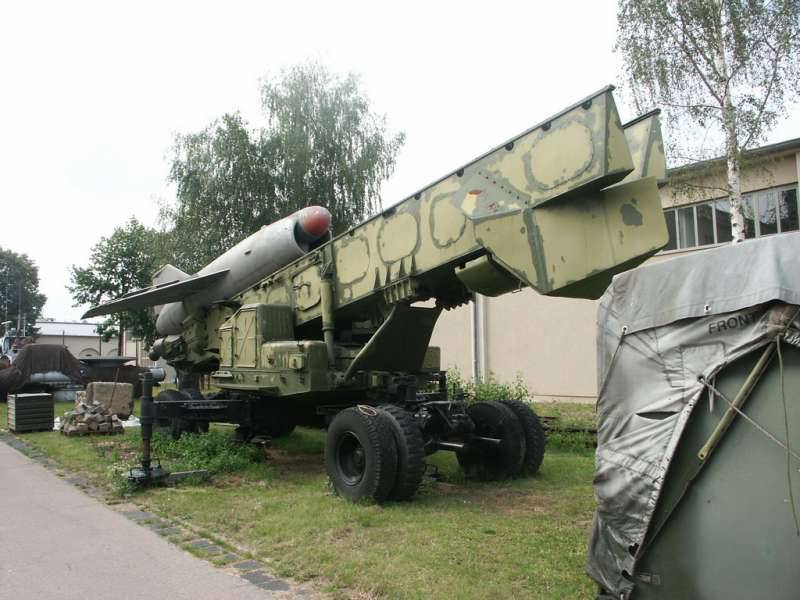
Launcher complex "Sopka" with a C-2 rocket. The design of the guide is unified with the units of the Strela system. Photo of Wikimedia Commons
A stationary launcher was developed to launch the C-2 rocket. The main element of this product was a launching beam with a length of 10 m, along which the rocket had to move at the start. When loading, the beam had to be positioned strictly horizontally, and for launch it rose at an angle of 10 °. Also in the complex "Strela" introduced rocket transporter, made in the form of a trolley with an electric motor. The task of the transporter was the delivery of products to the launchers.
In addition to the launchers and missiles in the complex included several radar stations. To monitor the situation and search for targets offered radar type "Cape". This system could be towed by tractors and relatively quickly transferred to a new position. Station "Cape" had the ability to detect surface objects at a distance of 185 km. At the same distance it was possible to determine the coordinates of the target for issuing target designation. To track the goal was planned to use the station "Burun" with characteristics at the level of "Cape".
For targeting missiles at the target radar was proposed C-1 (then C-1M). This system could operate at ranges up to 200 km and determine the distance to the target with an accuracy of up to 4-5 km. The main task of the C-1 station was to highlight the target with the formation of a reflected beam, which was supposed to be guided by a rocket.
The principle of the Strela complex was similar to the algorithms of other systems based on the KS-1 rocket. Being in a fixed position, the Cape station was supposed to monitor coastal waters within a radius of up to 185 km. When a potentially dangerous target was detected, the radar calculation had to identify it and target the control systems of the complex. After that, the work included the C-1 illumination station, which was used to track the target while simultaneously highlighting it.
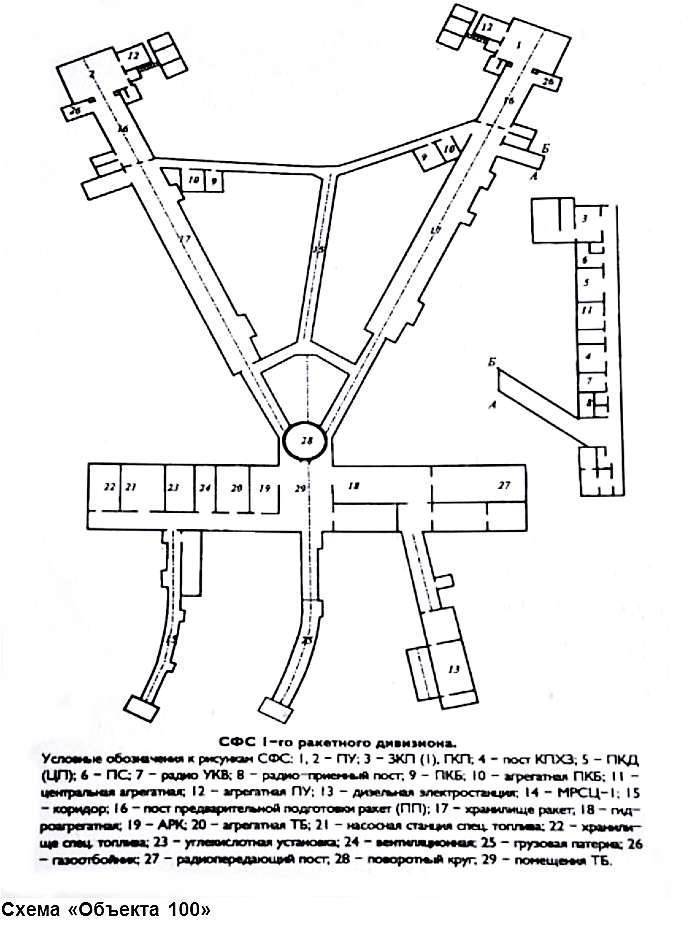
Scheme of the complex "Strela". Figure Ertata.ru
When the target entered the missile strike zone, it was proposed to launch. At the time of launch, the C-2 rocket was supposed to output the main turbojet engine at maximum speed, as well as launch a solid propellant. With the help of an accelerator, the rocket descended from the guide and picked up speed sufficient to hold it in the air. Then the flight was answered by the main engine. Immediately after the launch, the autopilot of the rocket independently drove it to a predetermined height and course, coinciding with the radar of guidance.
In the initial part of the flight with a length of up to several tens of kilometers, the missile control systems were to operate in mode "A". At the same time, the automation with the help of an altimeter retained the required height, and the course was determined by the beam of the coastal C-1 radar. The C-3 system kept the rocket in the beam and thus kept the approximate direction to the target. Having flown a predetermined distance, the rocket had to go into the target search mode - the so-called. mode "B".
At a distance of the order of 15-20 km from the target, the C-3 product began to search for the backlight radar signal reflected by it. After detecting the target and taking it to escort, the altitude corrector was turned off and the rocket began aiming at the target along the shortest path, maneuvering along the course and altitude. The launch result was to hit the missile at the target with its defeat due to the kinetic energy of the product and the 860-kg charge of the warhead. The tests of the KS-1 rocket have already managed to visually show how such an effect has on the target. weapon.
In the 1954 year, shortly after the start of the development of the C-2 project, a special commission of the Ministry of Defense carried out a search for a place to house the first coastal missile system. The construction of this object was proposed in the area of Balaclava in the south of Crimea. Soon there was a project developed in accordance with the existing landscape. The future missile system received the symbol "Object 100". In the course of this project, it was planned to build positions for two rocket battalions (near Balaklava and v. Reserve), separated by 6 km. The objects were to be built at a height of at least 500 above sea level and at some distance from the coastline, which increased the basic characteristics of the complex, and did not allow to notice secret positions from passing ships.
The project "Object 100" implied the construction of two complexes with its own means of storage, maintenance and launch of missiles. Each of these complexes from the point of view of organization was a division, and two were a missile regiment. In the thick of the mountain it was proposed to cut through a large number of different premises, from command posts to halls with launchers. For example, the latter had the appearance of recessed spaces with a movable metal roof. Before launching the roof had to open and allow the launcher to rise up to launch the rocket. The missiles were delivered to the launchers through extensive underground tunnels with rails. For transportation used transporters with electric motors.
Each of the 100 Object divisional complexes contained two launchers with two guides each. Thus, one volley of the entire Strela complex, located near Balaklava, could consist of eight guided missiles. This was enough to destroy a large ship or cause significant damage to the whole ship group.
On the cliff of Cape Aya it was proposed to build a position of the Cape detection radar. This station, fully deployed at high altitude, was supposed to search for targets for both the 100 Object missile systems. Nearby there were other stations involved in the combat operation of the Strela complex.
The construction of the 100 Facility began in the summer of 1955. The preparation of the underground premises and the installation of the necessary equipment was entrusted to 95-th specialized specialized management of the underground operations of the Black Sea Fleet. The size of the complex, as well as its location in the rock affected the timing of the work. The construction of two complexes in the rock mass and the installation of all the necessary equipment was completed in about two years. By the beginning of the summer of 1957, the 100 Object was ready to launch rockets. The operation of the new complex was assigned to a specially formed 362-th separate coastal missile regiment.
Shortly after the start of construction of the “100 Object”, work began on the creation of a second such complex. They decided to locate it on the island of Kildin in the Barents Sea and put it at the disposal of the Northern Fleet. By analogy with the first complex of the system, o. Kildin called "Object 101". As in the Crimea, two divisional complexes were built at a distance of about 8 km from each other. Interestingly, Strela for the Northern Fleet was built using a new technology. Instead of punching adits deep into the mountains, the builders dug out pits of the required dimensions, in which the necessary objects were built. The 101 th separate coastal missile regiment was to serve the 616 Object.
The first launch of the C-2 rocket complex "Strela", built on the Crimean coast, took place on 5 June 1957 of the year. Over the next month, nine more launches took place. The first checks of the missiles and the complex, in general, gave a good result. 10 4 missiles struck a training target, another 2 - hit the so-called. given Four launches failed. Officially, “100 Object” launched 30 August 1957 of the year.
The first rocket launch from about. Kildin hosted 16 October 1957 of the year. From a distance of 70 km, the C-2 rocket successfully hit the decommissioned tugboat with corner reflectors imitating a large-sized combat ship. According to the results of tests that took place in the last months of 1957, the "101 Object" was put on alert. Officially, his service began on January 6 1958.
Of particular interest are the shootings conducted by the separate regiment of the 362 in October of the 1958 year. At that time, the Main Inspectorate of the Ministry of Defense headed by Marshal of the Soviet Union K.K. Rokossovsky. One of the checks affected the 100 Object missiles. October 4 calculations of both divisions performed inspection shooting at the training target at maximum range. All fired missiles reached the target and caused her fatal damage. Shooting was performed on the rating of "excellent." The entire personnel of the regiment received thanks from Marshal Rokossovsky.
From the beginning of 1958, the coastal missile forces and artillery of the navy of the Soviet Union had two bases armed with cruise anti-ship missiles. These objects made it possible to protect large areas of the coast from attacks from the sea with sufficient effectiveness. Nevertheless, despite all the advantages, the 100 Object and 101 Object turned out to be the first and last similar bases in our country. Already in the late fifties, it was decided to gradually reduce the role of stationary coastal missile systems, giving priority to mobile systems.
The fate of the Strela complex and other similar systems was affected by the further development of rocket technology. In 1955, on the basis of developments on the Strela, they began to create a mobile coastal complex Sopka of a similar purpose with a rocket, which is a further development of the C-2 product. The use of ready-made developments and existing experience allowed us to quickly complete all the necessary work and release the Sopka to the tests. In December, 1958, this complex was adopted, and soon began mass production of all of its funds with their transfer to the coastal forces of all Soviet fleets. The relative simplicity of the mobile complex made it possible to deploy it in almost any area without significant efforts and the construction of complex specialized objects, like bases in the Crimea or on the island. Kildin.
The Sopka mobile missile system, capable of changing positions, had great tactical advantages over the stationary Strela, which risked becoming one of the main targets for hitting the enemy. At the same time, almost all systems of the mobile complex were either unified with the Strela facilities, or represented their further development. As a result, the general characteristics of the two missile systems were approximately at the same level. This feature of the two complexes could not help but be the subject of controversy about the further development of coastal-based missiles.
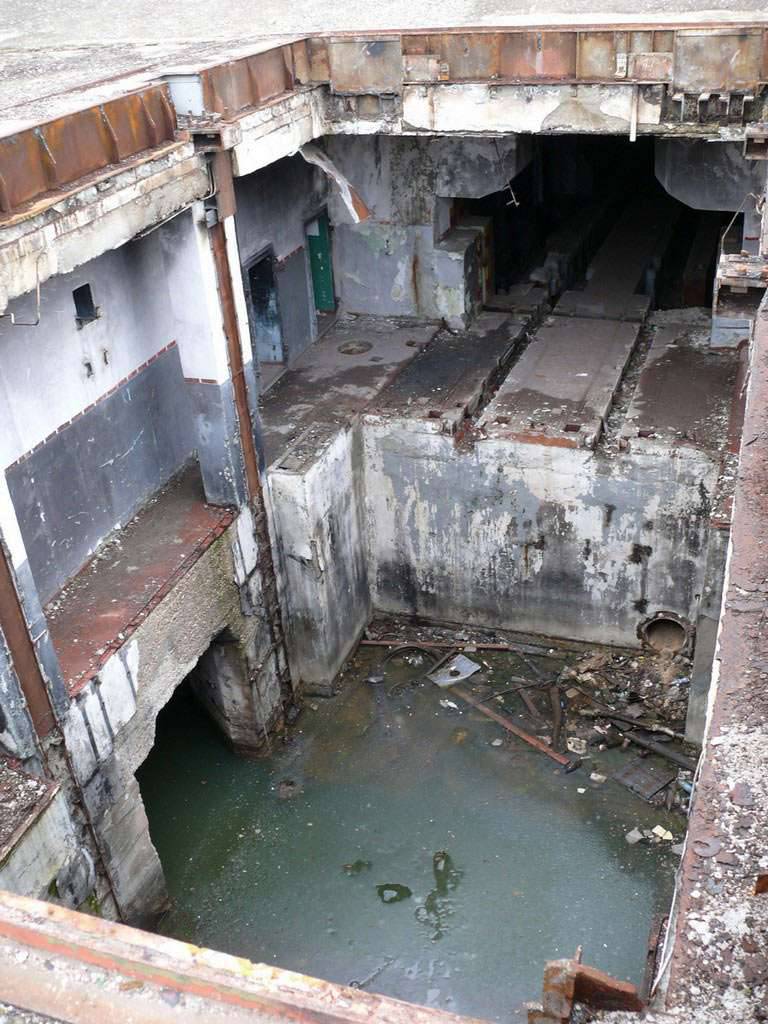
Underground structures launcher, plundered. Visible rails for the supply of missiles. Photo by Jalita.com
The high degree of unification of the two missile systems, as well as the existing difference in basing, forced the fleet command to correct its plans for the development of coastal anti-ship systems. In connection with the advent of mobile systems, the need for stationary complexes has disappeared. In addition, there is no need to build complex onshore facilities like the 100 Object. For comparison, the mobile "Sopka" needed only roads and specially equipped platforms for the deployment of various means. As a result, in the late fifties, it was decided to focus on the creation of mobile complexes. However, this did not lead to the complete rejection of stationary ones and did not put an end to their stories.
Despite the appearance of the Sopka complex, the Strela systems with C-2 missiles were not decommissioned. They were exploited until the 1965 year and defended the shores of the country from a possible attack. The personnel of two separate missile regiments regularly conducted training firing and practiced other procedures related to the operation of various systems. According to reports, from 1957 to 1965 a year (including testing), two divisions of the 100 Object spent 25 C-2 missiles. 18 launches ended in a successful defeat of training targets that mimic the enemy ships. There is no similar data for the “101 Object”.
In 1964, it was decided to abandon the operation of the Strela complexes and C-2 missiles due to their moral obsolescence. In order to preserve two objects in the Crimea and on about. Kildin was decided to deploy a new stationary missile complex "Utes", which became the basis of anti-ship missile P-35. For some reason, work on this project was delayed, which is why the 362-th separate coastal missile regiment switched to a new weapon only in the early seventies. In 1976, the first division of the 616 regiment switched to new missiles. The second complex of the 101 Object was rearmed only at 1983.
According to reports, the “101 Object” ceased to exist in the 1995 year. Due to economic problems and the revision of the 616 strategy, a separate coastal missile regiment was disbanded and withdrawn from Kaldin Island. The “100 object” still exists, but in the past it has run into serious problems. In the mid-nineties, he was handed over to the naval forces of Ukraine, after which one of the divisions (according to some information, division No. XXUMX) was mothballed, and the second was plundered. In 2, it was reported that the Russian Navy specialists managed to restore the mothballed complex, which made it possible to resume its operation. Thus, the facility, built almost 2014 years ago, can once again serve its country.
Based on:
http://bratishka.ru/
http://vpk-news.ru/
http://bastion-opk.ru/
http://ostrov-kildin.narod.ru/
http://jalita.com/
Shirokorad A.B. Weapons of the domestic fleet. 1945-2000. - Minsk: “Harvest”, 2001
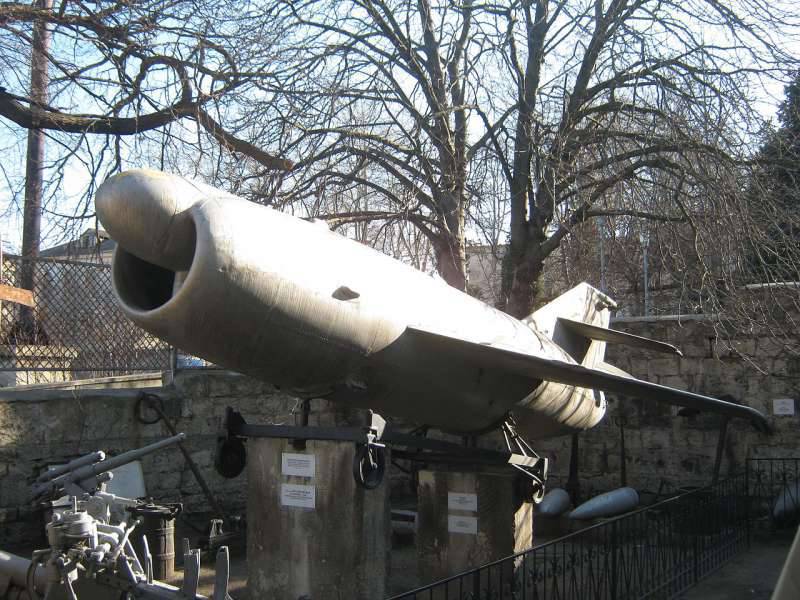
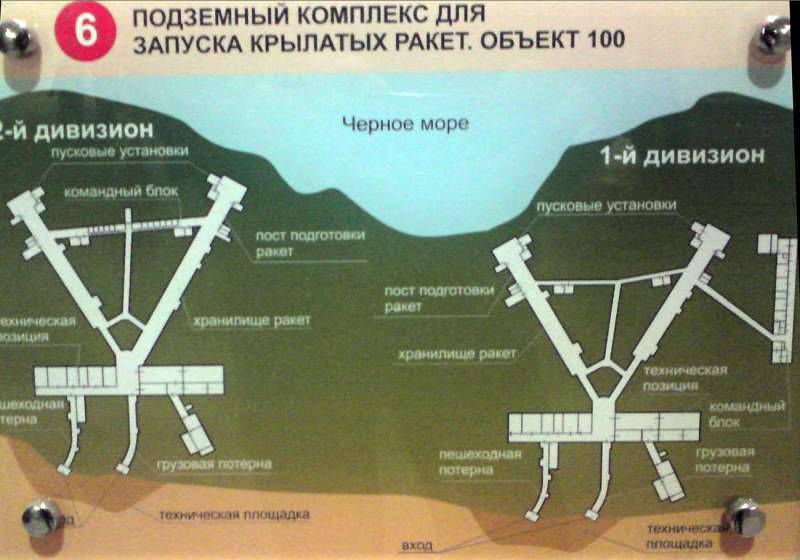
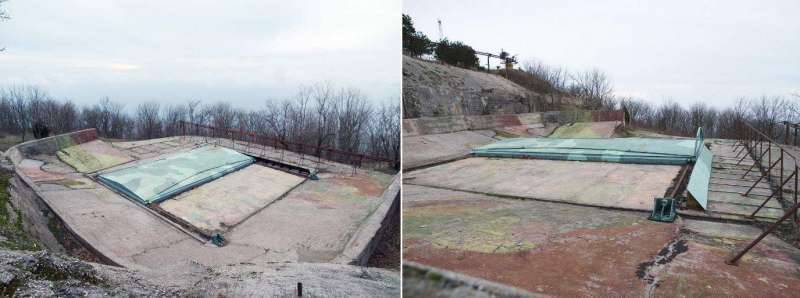
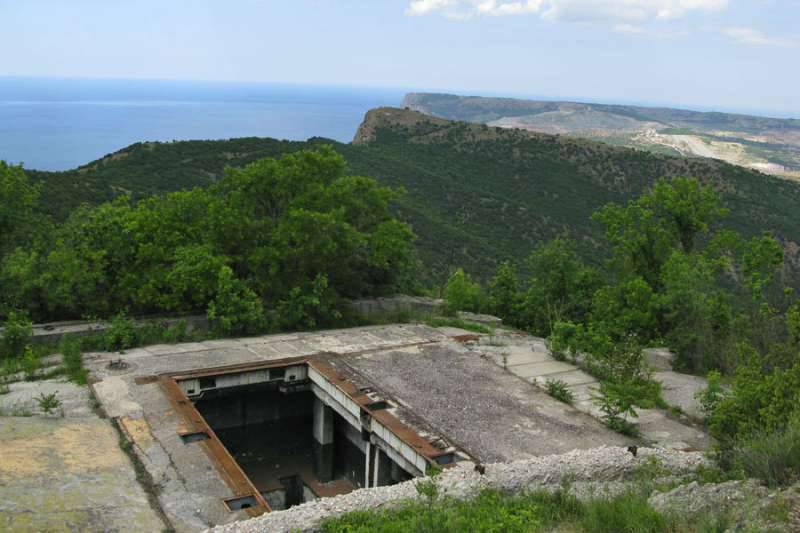
Information